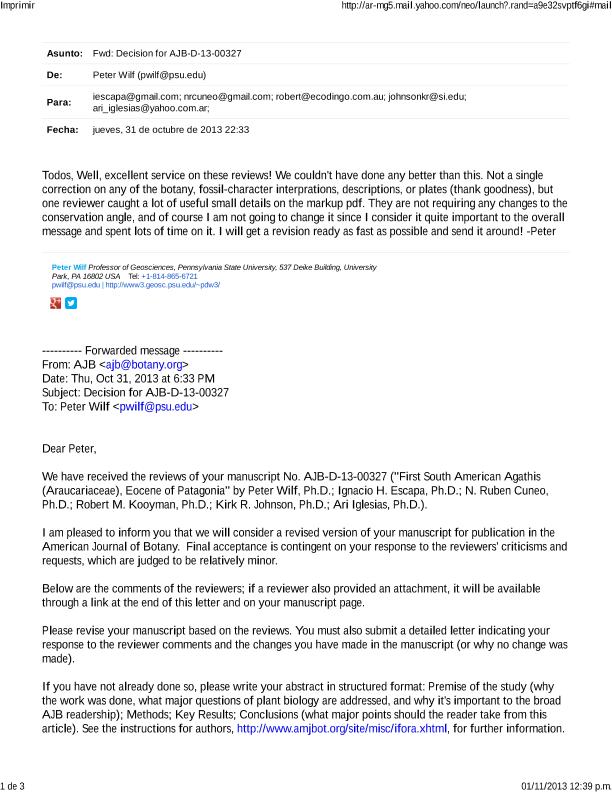Mostrar el registro sencillo del ítem
dc.contributor.author
Wilf, Peter
dc.contributor.author
Escapa, Ignacio Hernán

dc.contributor.author
Cúneo, Rubén
dc.contributor.author
Kooyman, Robert M.
dc.contributor.author
Johnson, Kirk R.
dc.contributor.author
Iglesias, Ari

dc.date.available
2017-11-06T17:00:44Z
dc.date.issued
2014-01-13
dc.identifier.citation
Wilf, Peter; Escapa, Ignacio Hernán; Cúneo, Rubén; Kooyman, Robert M.; Johnson, Kirk R.; et al.; First South American Agathis (Araucariaceae), eocene of Patagonia; Botanical Society of America; American Journal of Botany; 101; 1; 13-1-2014; 156-179
dc.identifier.issn
0002-9122
dc.identifier.uri
http://hdl.handle.net/11336/27660
dc.description.abstract
- Premise of the study: Agathis is an iconic genus of large, ecologically important, and economically valuable conifers that range over lowland to upper montane rainforests from New Zealand to Sumatra. Exploitation of its timber and copal has greatly reduced the genus’s numbers. The early fossil record of Agathis comes entirely from Australia, often presumed to be its area of origin. Agathis has no previous record from South America.
- Methods: We describe abundant macrofossils of Agathis vegetative and reproductive organs, from early and middle Eocene rainforest paleofloras of Patagonia, Argentina. The leaves were formerly assigned to the New World cycad genus Zamia.
- Key results: Agathis zamunerae sp. nov. is the first South American occurrence and the most complete representation of Agathis in the fossil record. Its morphological features are fully consistent with the living genus. The most similar living species is A. lenticula, endemic to lower montane rainforests of northern Borneo.
- Conclusions: Agathis zamunerae sp. nov. demonstrates the presence of modern-aspect Agathis by 52.2 mya and vastly increases the early range and possible areas of origin of the genus. The revision from Zamia breaks another link between the Eocene and living floras of South America. Agathis was a dominant, keystone element of the Patagonian Eocene floras, alongside numerous other plant taxa that still associate with it in Australasia and Southeast Asia. Agathis extinction in South America was an integral part of the transformation of Patagonian biomes over millions of years, but the living species are disappearing from their ranges at a far greater rate.
dc.format
application/pdf
dc.language.iso
eng
dc.publisher
Botanical Society of America

dc.rights
info:eu-repo/semantics/openAccess
dc.rights.uri
https://creativecommons.org/licenses/by-nc-sa/2.5/ar/
dc.subject
Agathis
dc.subject
Araucariaceae
dc.subject
Argentina
dc.subject
Borneo
dc.subject
Conifers
dc.subject
Eocene
dc.subject
Extinction
dc.subject
Laguna del Hunco
dc.subject
Rainforests
dc.title
First South American Agathis (Araucariaceae), eocene of Patagonia
dc.type
info:eu-repo/semantics/article
dc.type
info:ar-repo/semantics/artículo
dc.type
info:eu-repo/semantics/publishedVersion
dc.date.updated
2017-08-09T14:23:07Z
dc.journal.volume
101
dc.journal.number
1
dc.journal.pagination
156-179
dc.journal.pais
Estados Unidos

dc.journal.ciudad
St. Louis
dc.description.fil
Fil: Wilf, Peter. State University of Pennsylvania; Estados Unidos
dc.description.fil
Fil: Escapa, Ignacio Hernán. Museo Paleontológico Egidio Feruglio; Argentina. Consejo Nacional de Investigaciones Científicas y Técnicas; Argentina
dc.description.fil
Fil: Cúneo, Rubén. Museo Paleontológico Egidio Feruglio; Argentina
dc.description.fil
Fil: Kooyman, Robert M.. National Herbarium of New South Wales, Sidney; Australia
dc.description.fil
Fil: Johnson, Kirk R.. National Museum Of Natural History, Smithsonian; Estados Unidos
dc.description.fil
Fil: Iglesias, Ari. Consejo Nacional de Investigaciones Científicas y Técnicas. Centro Científico Tecnológico Conicet - Patagonia Norte. Instituto de Investigaciones En Biodiversidad y Medioambiente. Universidad Nacional del Comahue. Centro Reg.universidad Bariloche. Instituto de Investigaciones En Biodiversidad y Medioambiente; Argentina
dc.journal.title
American Journal of Botany

dc.relation.alternativeid
info:eu-repo/semantics/altIdentifier/url/http://www.amjbot.org/content/101/1/156.full
dc.relation.alternativeid
info:eu-repo/semantics/altIdentifier/url/https://www.ncbi.nlm.nih.gov/pubmed/24418576
dc.relation.alternativeid
info:eu-repo/semantics/altIdentifier/doi/http://dx.doi.org/10.3732/ajb.1300327
Archivos asociados
